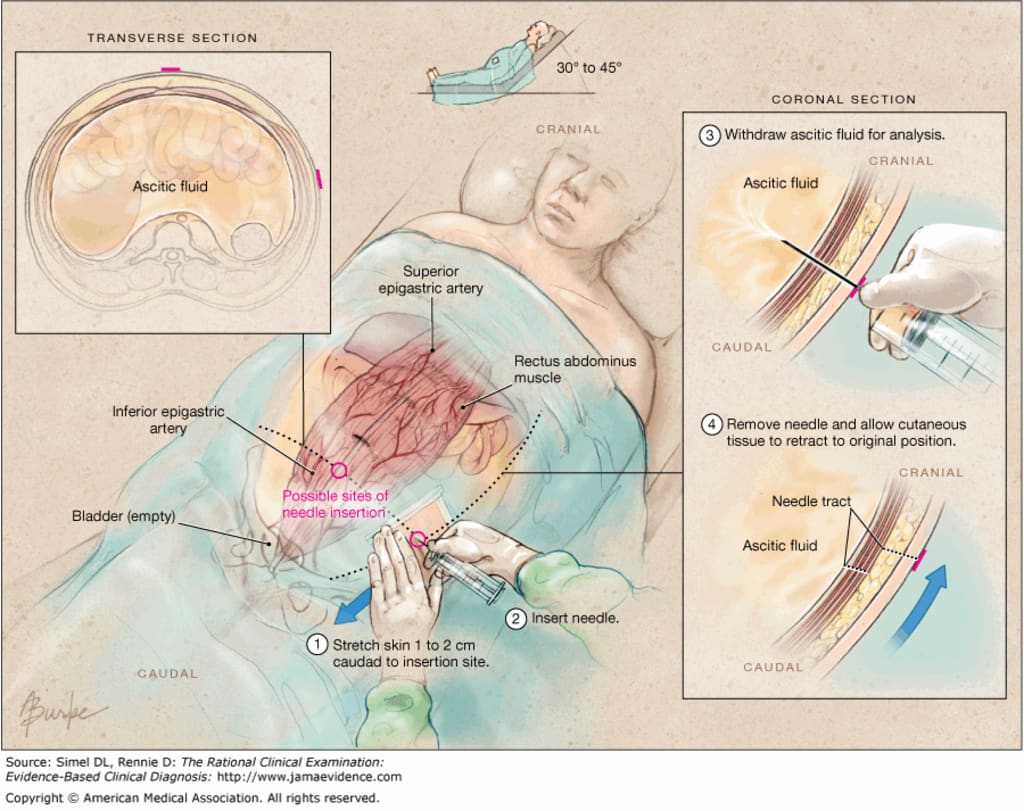My Experience with Paracentesis
An Overview of Paracentesis with First-Hand Experience

No one really wants to undergo paracentesis; however, the procedure is quite quick and simple. You begin to feel better almost instantly.
Paracentesis is a procedure that is conducted when a patient has ascites, which is a build-up of fluid in the abdomen. This can be caused by different diseases including:
- Liver disease
- Cancer
- Kidney disease
- Heart failure
For me personally, I have been diagnosed with liver cirrhosis and recently had to have paracentesis done for the first time. We will go over the procedure, and I can add some information from my experience to help you feel more comfortable about this subject.
The Procedure
This procedure is normally done in the emergency room or in the diagnostic department. If it is your first time, the doctor will generally use an ultrasound machine to help find the fluid and the best area to drain from.
First, you will be scanned and they will determine the best place to insert the needle and tube. Once that has been determined, the doctor will then inject some numbing medication into the area. This does sting a lot. They use a very generous amount because it is a tender area to be working in. Mine was done in the lower right side of the abdomen, which is where they prefer to do it.
Next, a needle will be inserted into the area and a small catheter is put in. The needle is removed and the catheter will then begin to drain the fluid. This part does not hurt. The most you should feel is a little pressure when the tube pops into place. It is a bit uncomfortable and a bit strange, but I did not experience any pain during the actual draining.
The doctor may leave you with a nurse at this time. They will monitor the fluid with the ultrasound machine. They may have you turn on your side to help you drain. But you will simply lay there and rest until they get all they can out.
I had three liters drained from my abdomen. If you get up to four liters, they may hook you to an IV so that you don't become dehydrated.
The entire procedure takes between 20 and 45 minutes on average.
After the Procedure
Once complete, they will put a bandage on the site. Sometimes you may be watched for an hour to make sure your blood pressure and heart rate stay stable.
The risks afterward include:
- Infection
- Internal bleeding
- Kidney problems
If you experience any of these symptoms, go and see your doctor or emergency room:
- Fever about 38C (100F)
- Severe stomach pain
- Bleeding from the site
- Blood in urine
I was unlucky enough to have a small amount of internal bleeding and also an infection. The internal bleeding caused me extreme pain in my stomach that had me doubled over. That was an emergency room trip for me and they determined that I bled slightly. When I saw my doctor after, she also gave me antibiotics, as my blood work showed I was fighting an infection. This cleared up easily.
Try not to stress out about this procedure if you have to have it. Everything sounds scarier than it looks. The needle is long, and the fact that they are taking fluid from your body is strange. But it is a very common procedure and has very few risks. Some people may have to have it done more than once.
The relief and pressure release that you feel afterward is well worth it.
About the Creator
Tanya Huffman
I am a 39 year old woman from Alberta, Canada living with a number of different health issues. Come follow my journey and hopefully you can find some comfort and answers about your own health!
Enjoyed the story? Support the Creator.
Subscribe for free to receive all their stories in your feed. You could also pledge your support or give them a one-off tip, letting them know you appreciate their work.






Comments
There are no comments for this story
Be the first to respond and start the conversation.